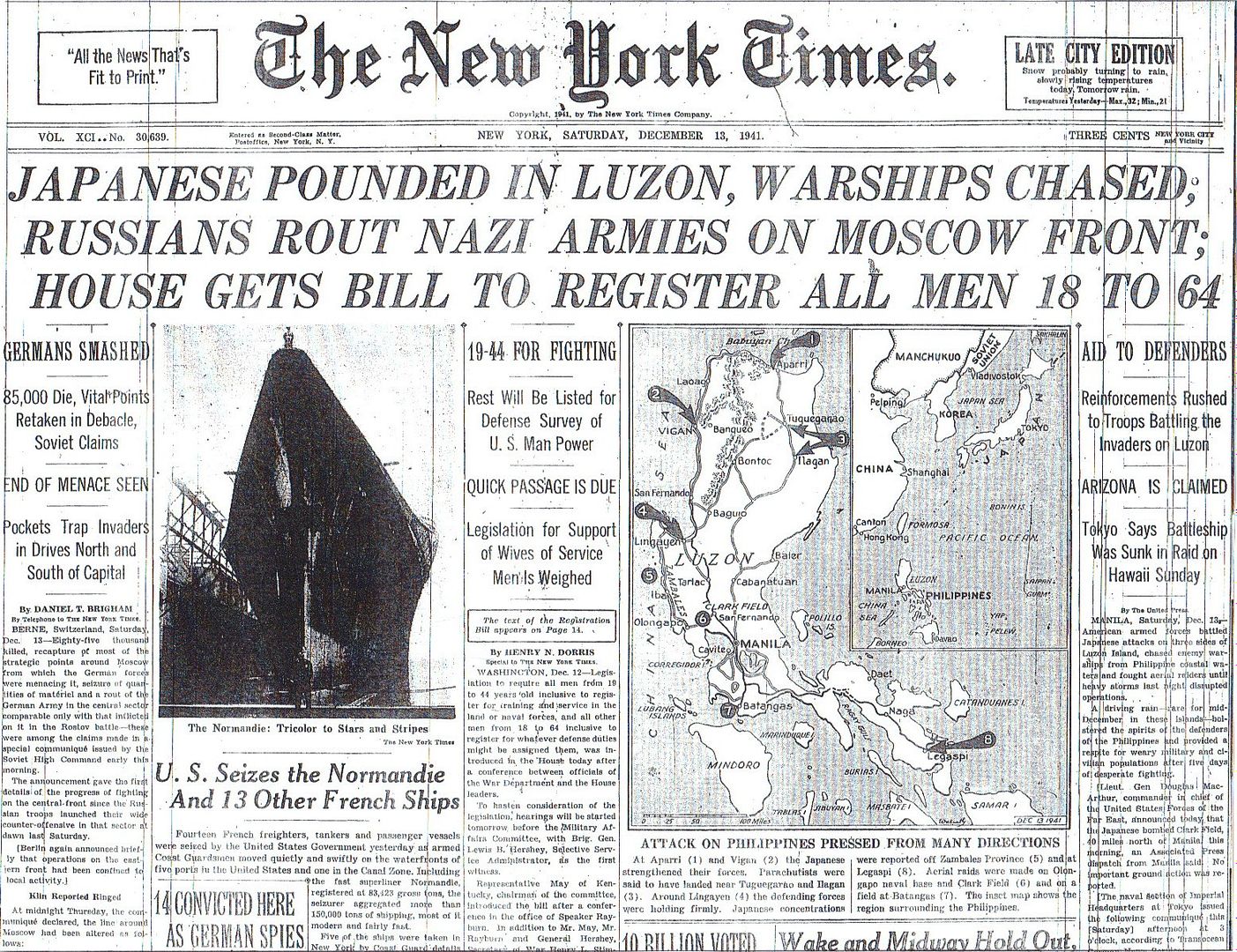
Posted on 12/13/2011 4:50:20 AM PST by Homer_J_Simpson

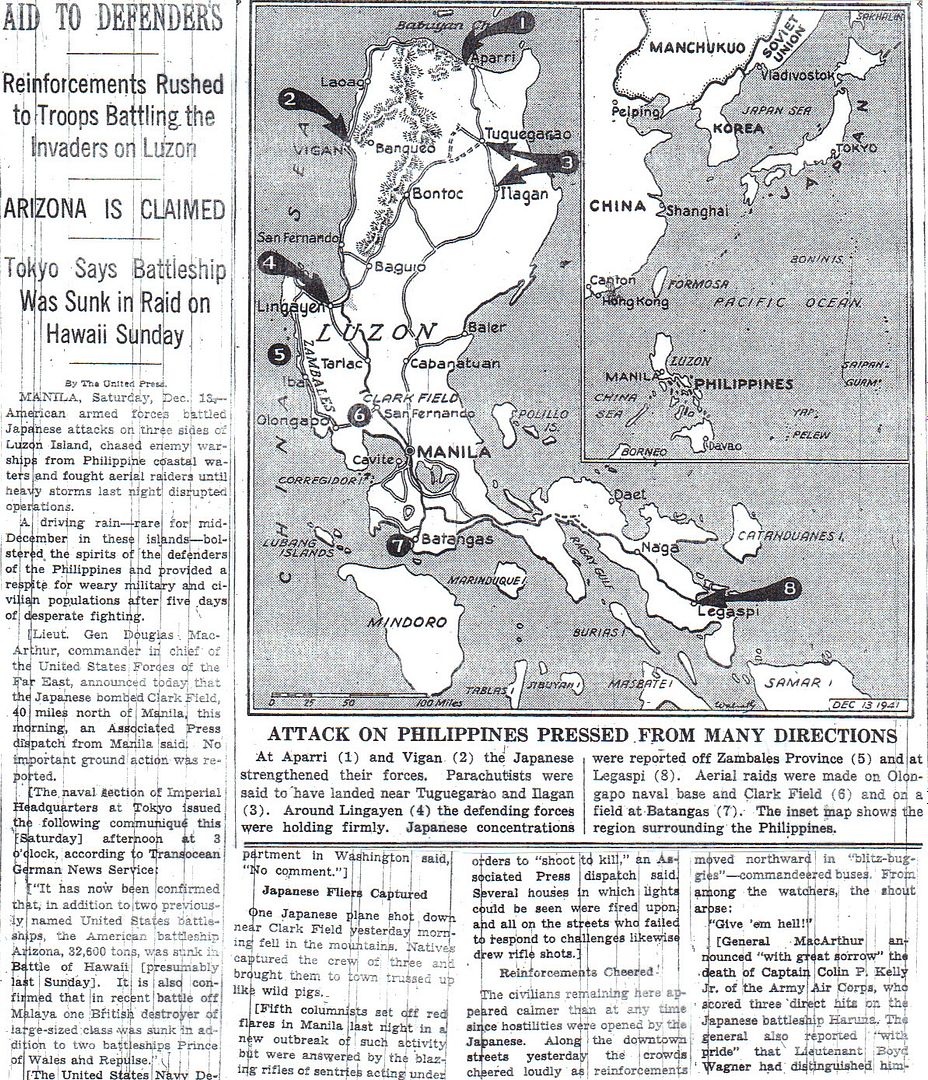


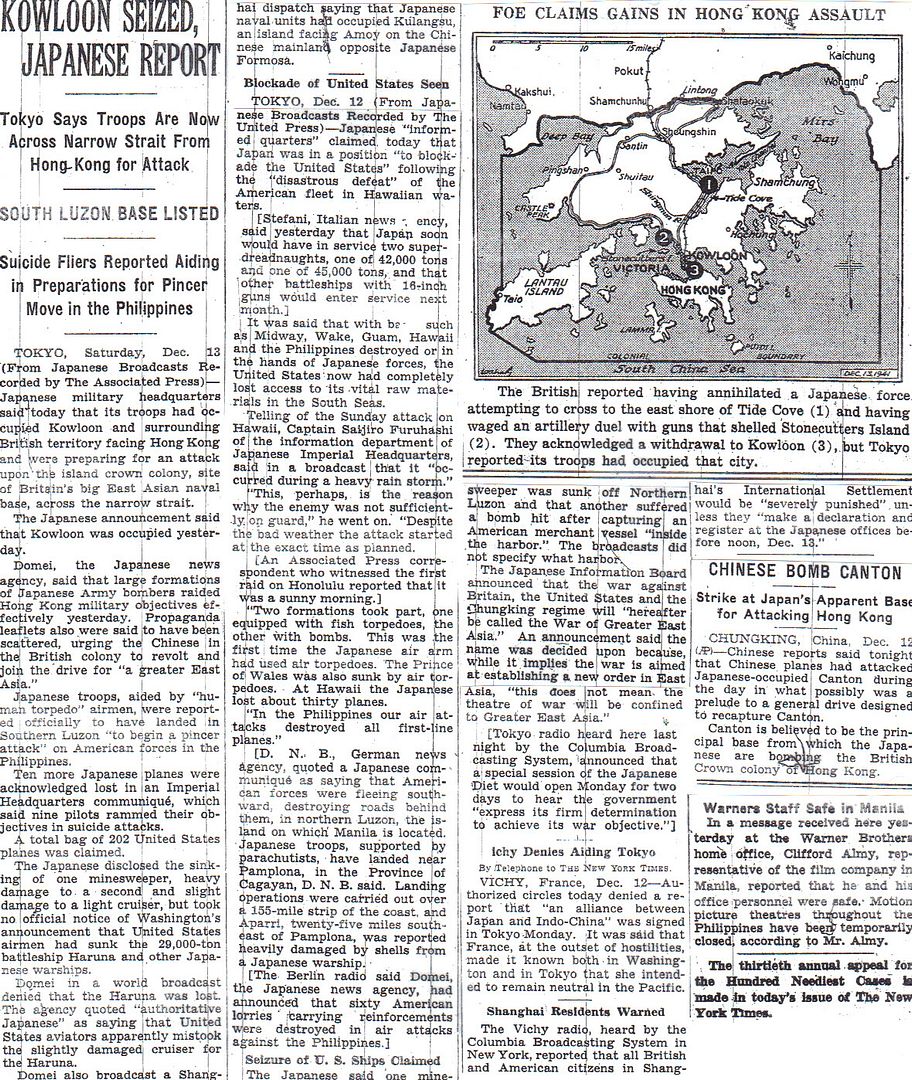

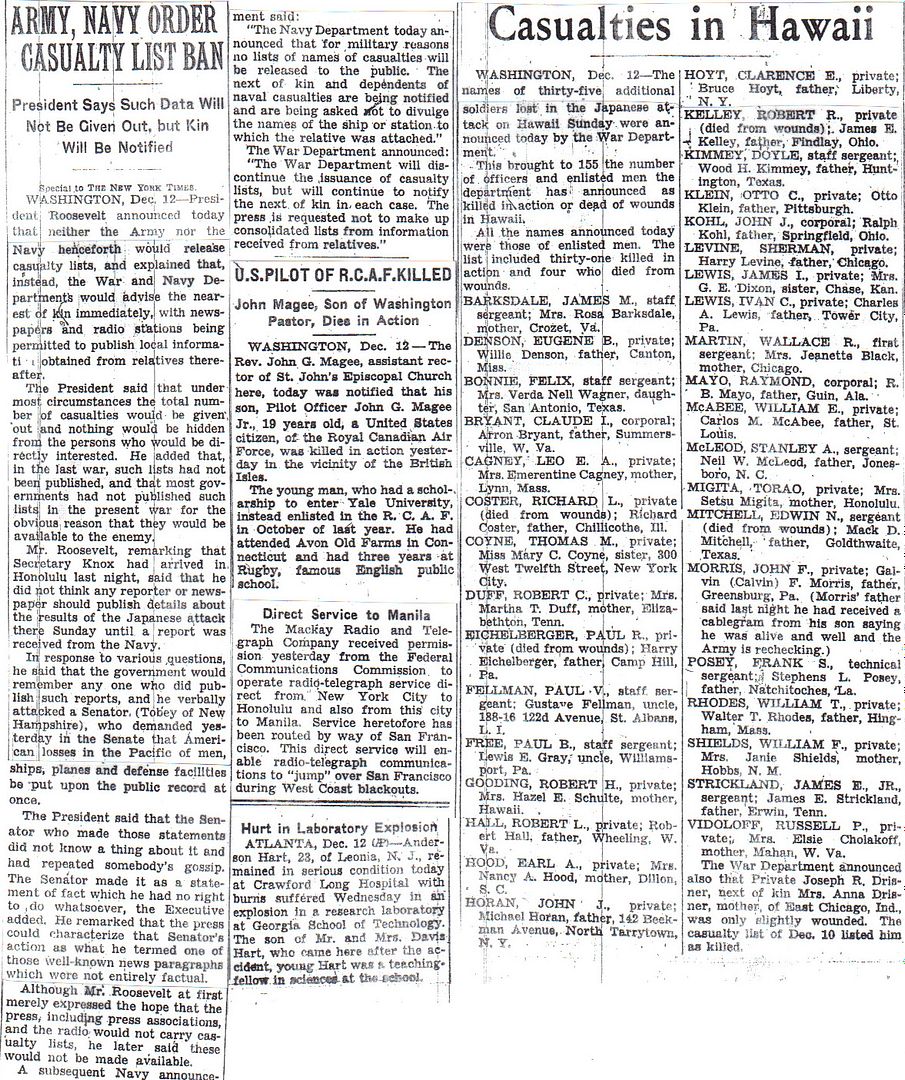
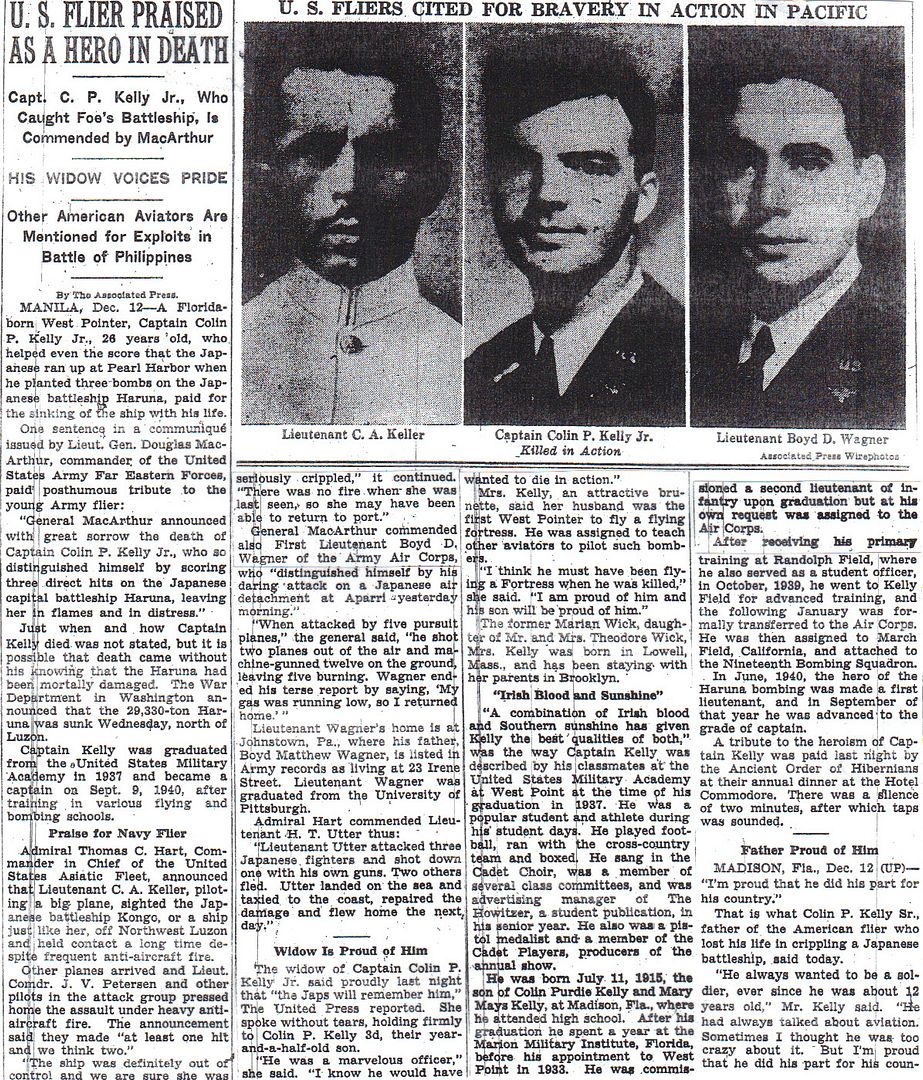
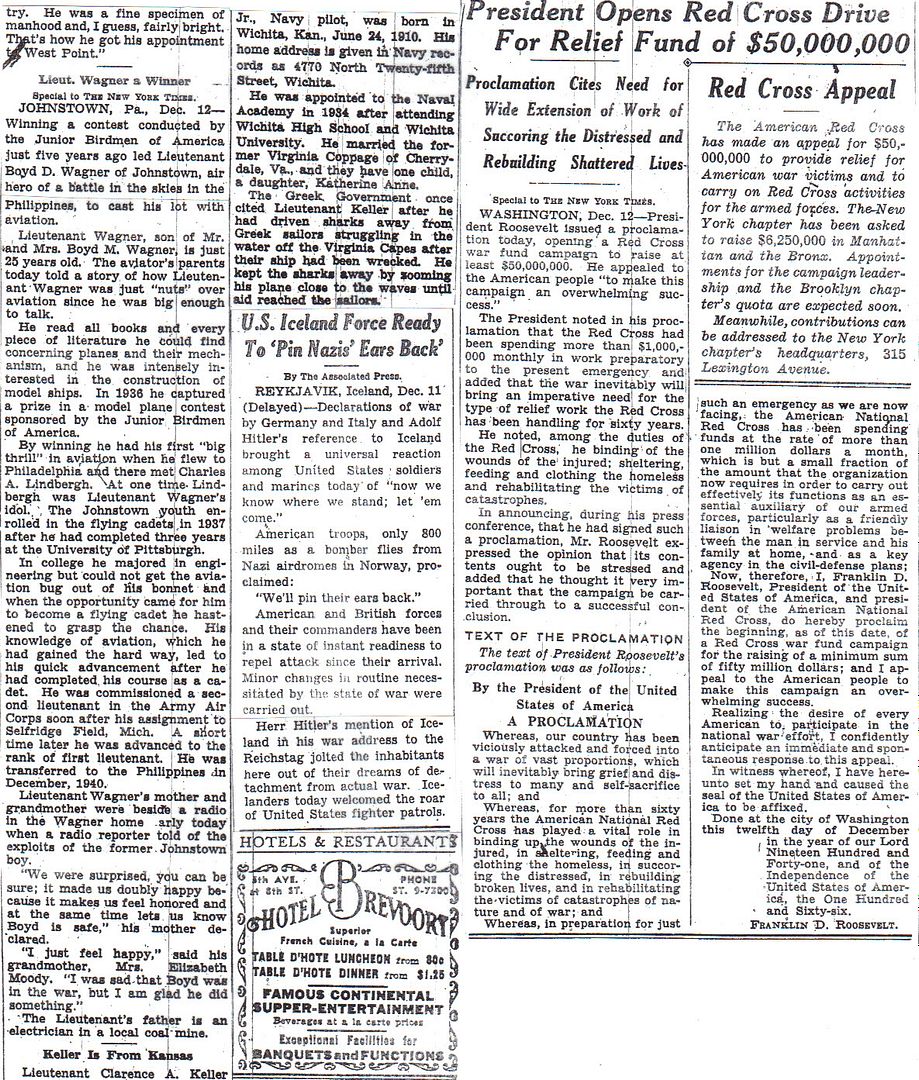
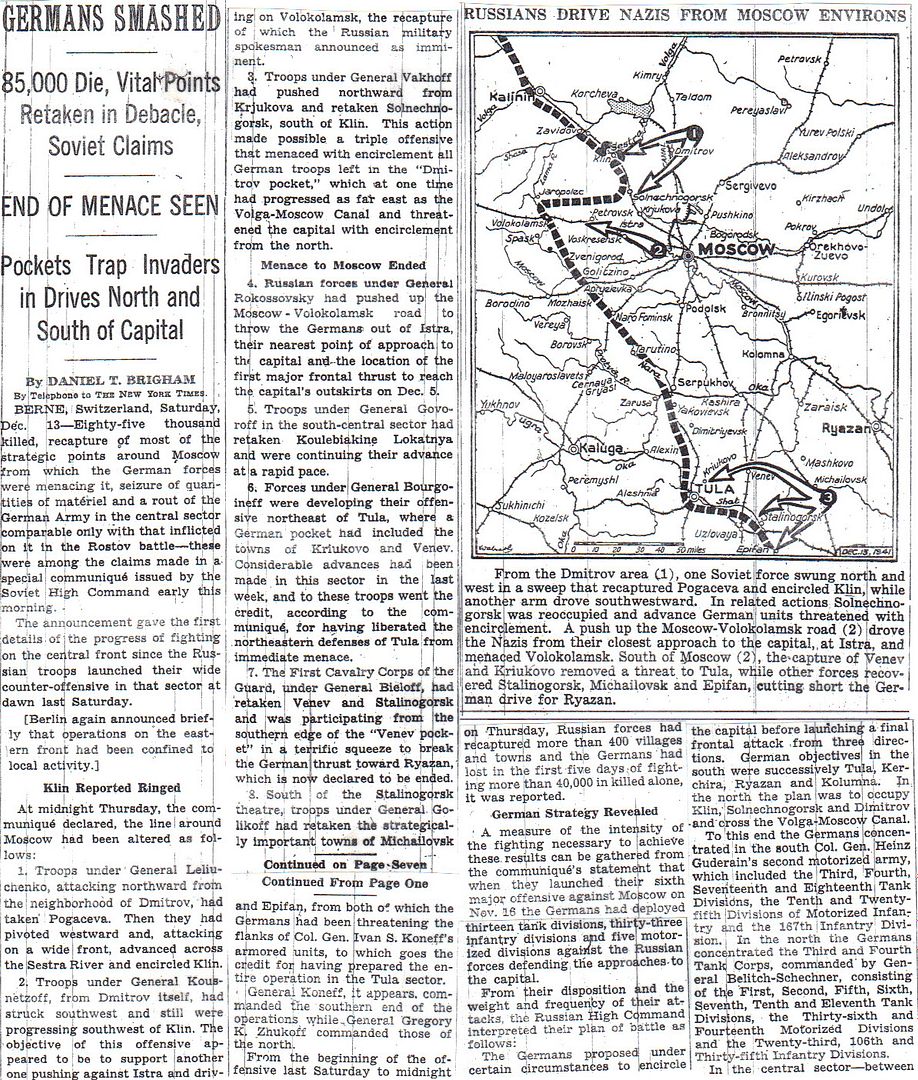
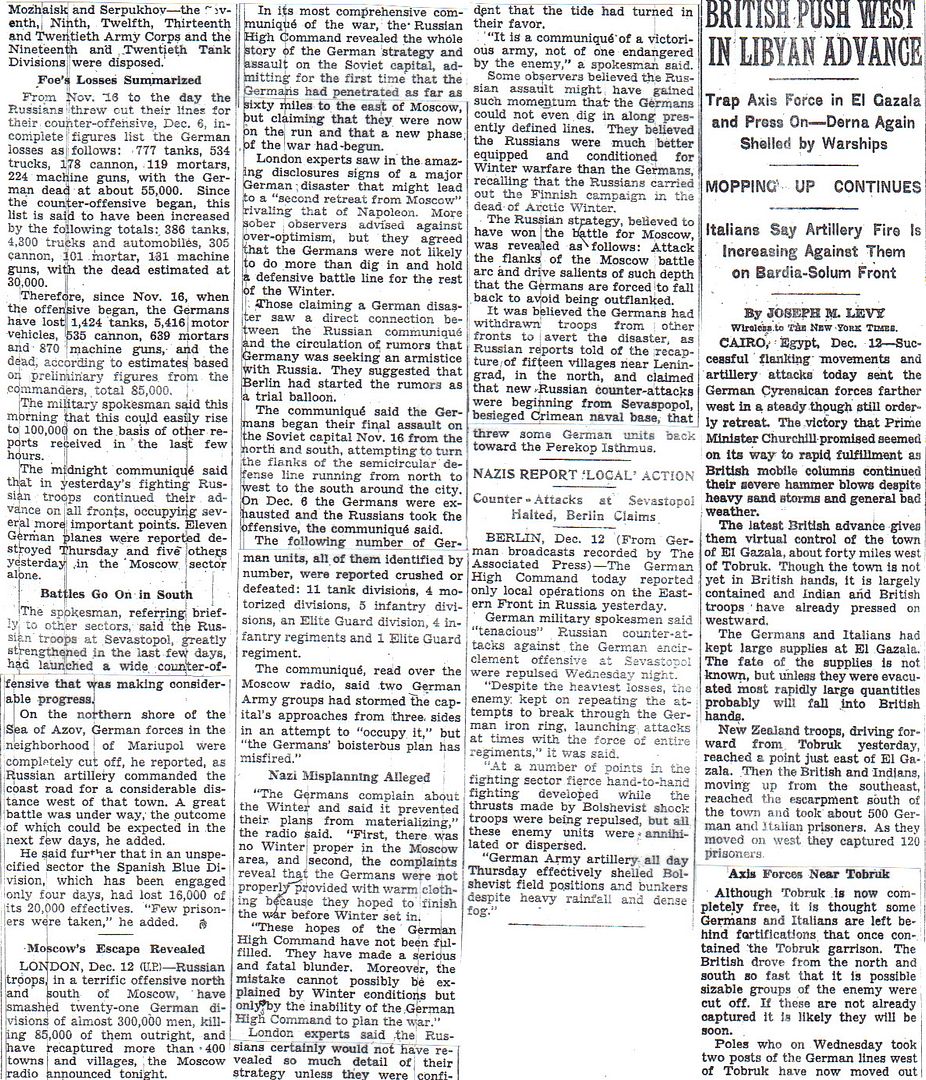
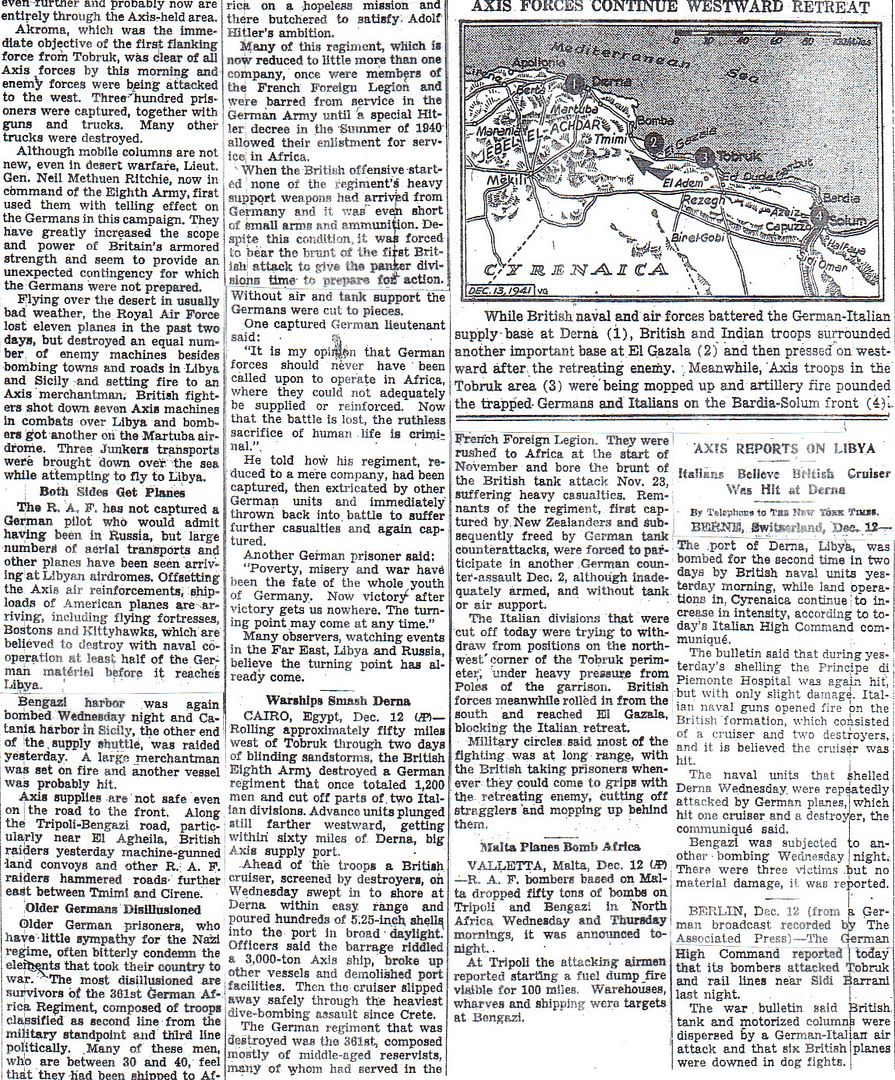
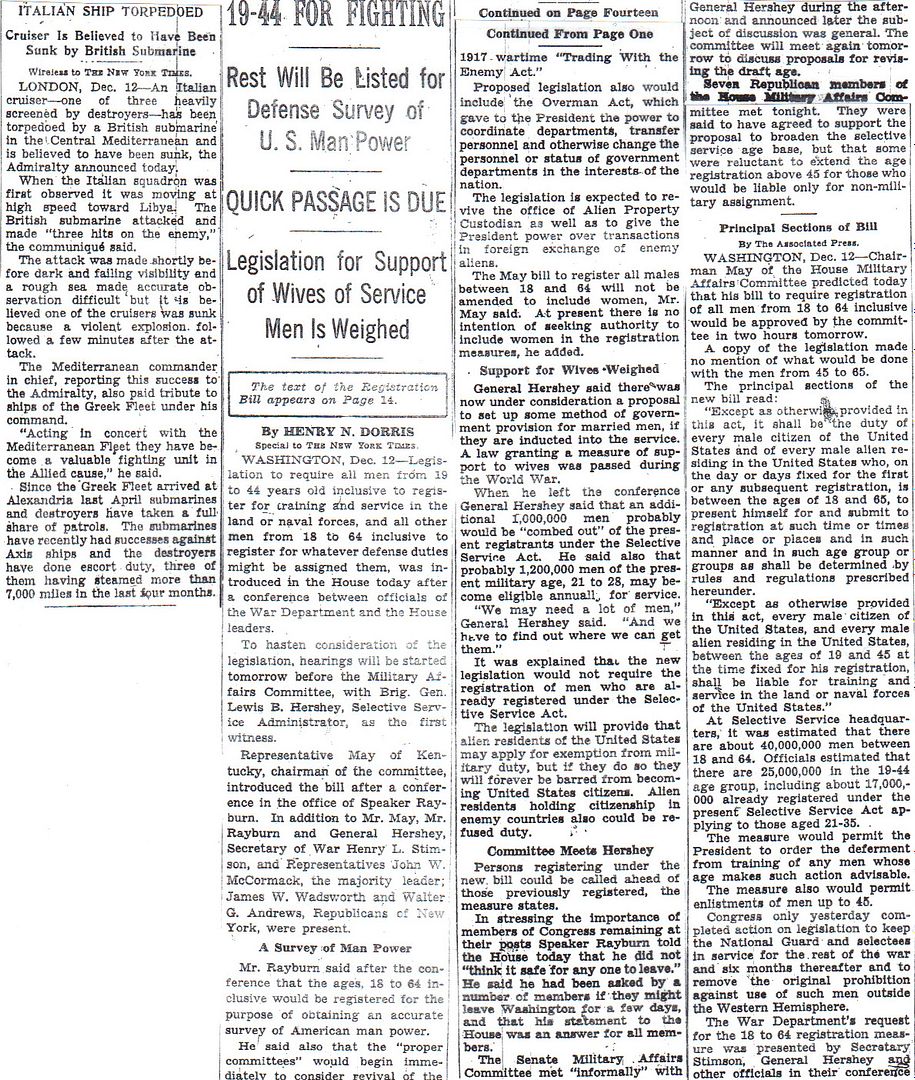
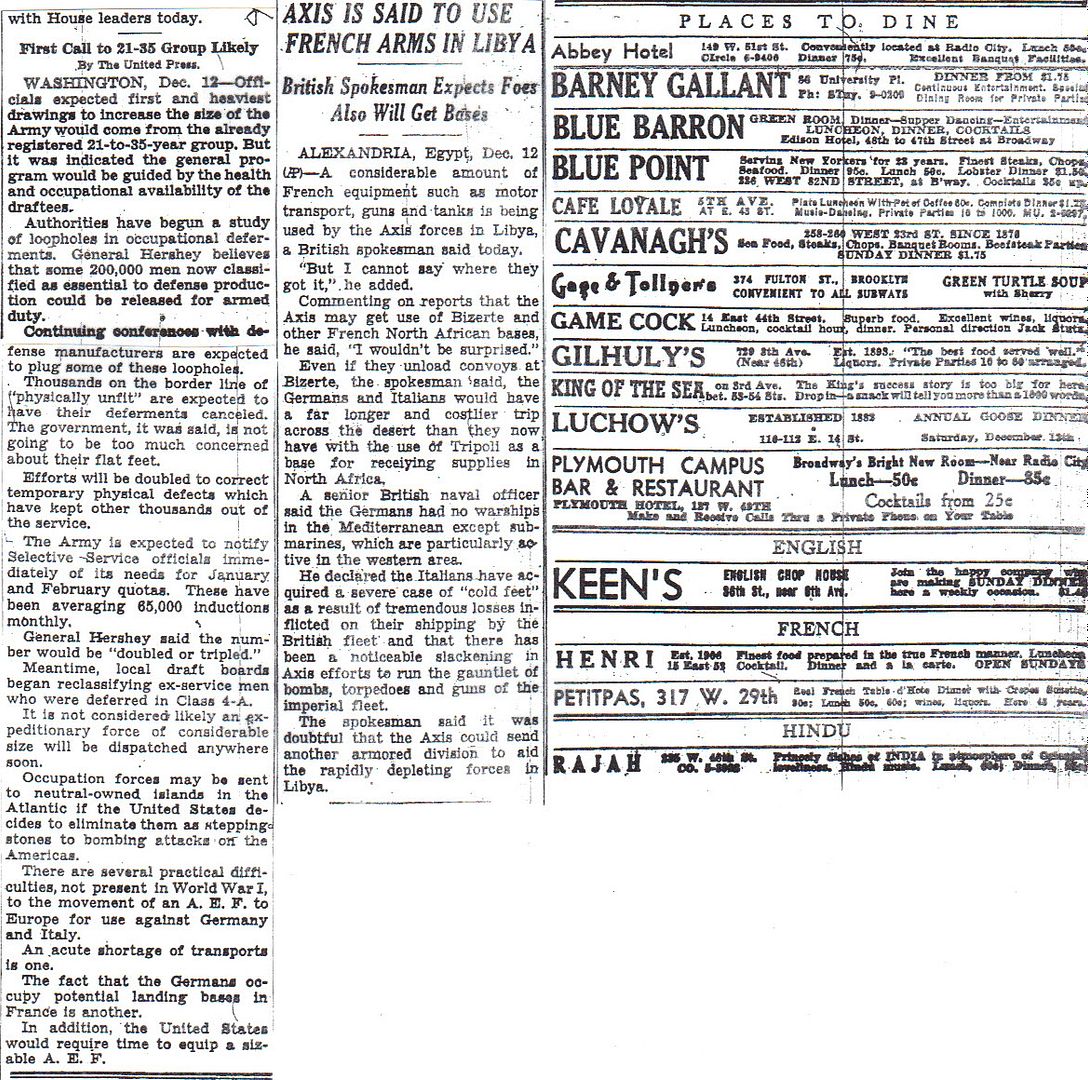
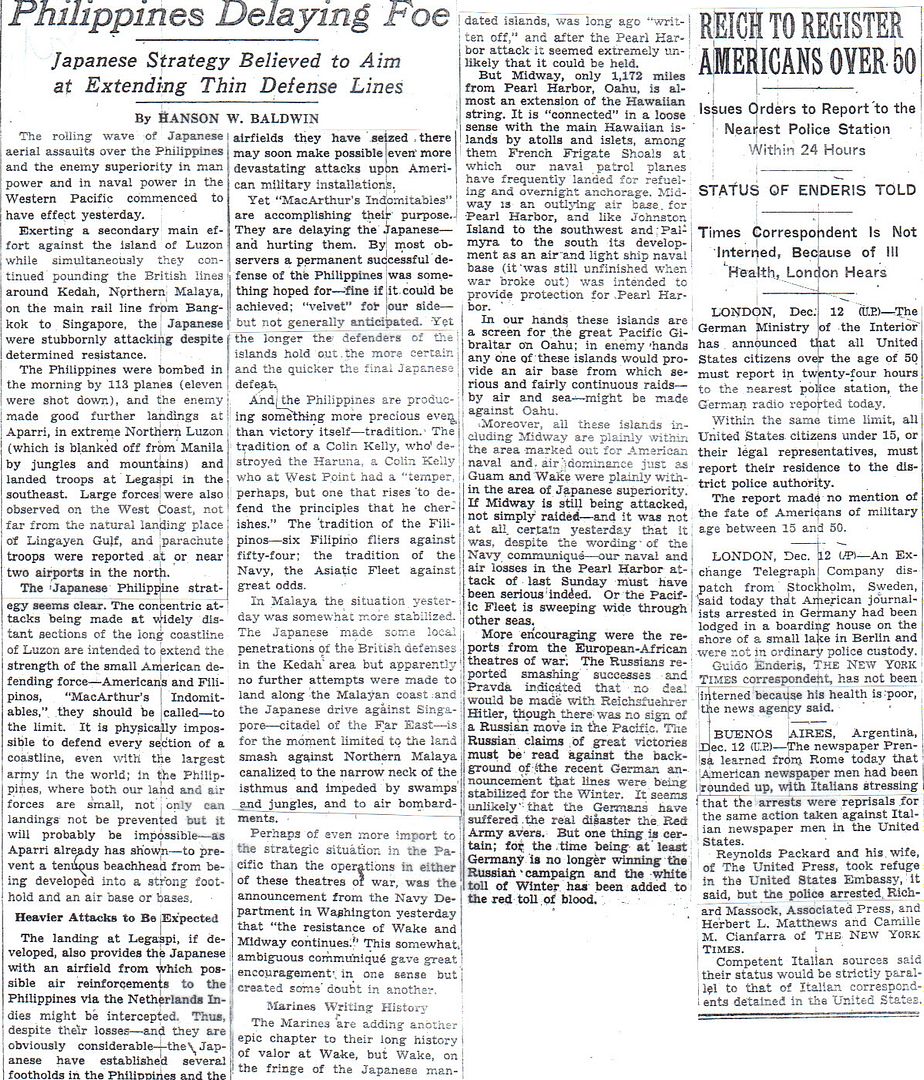
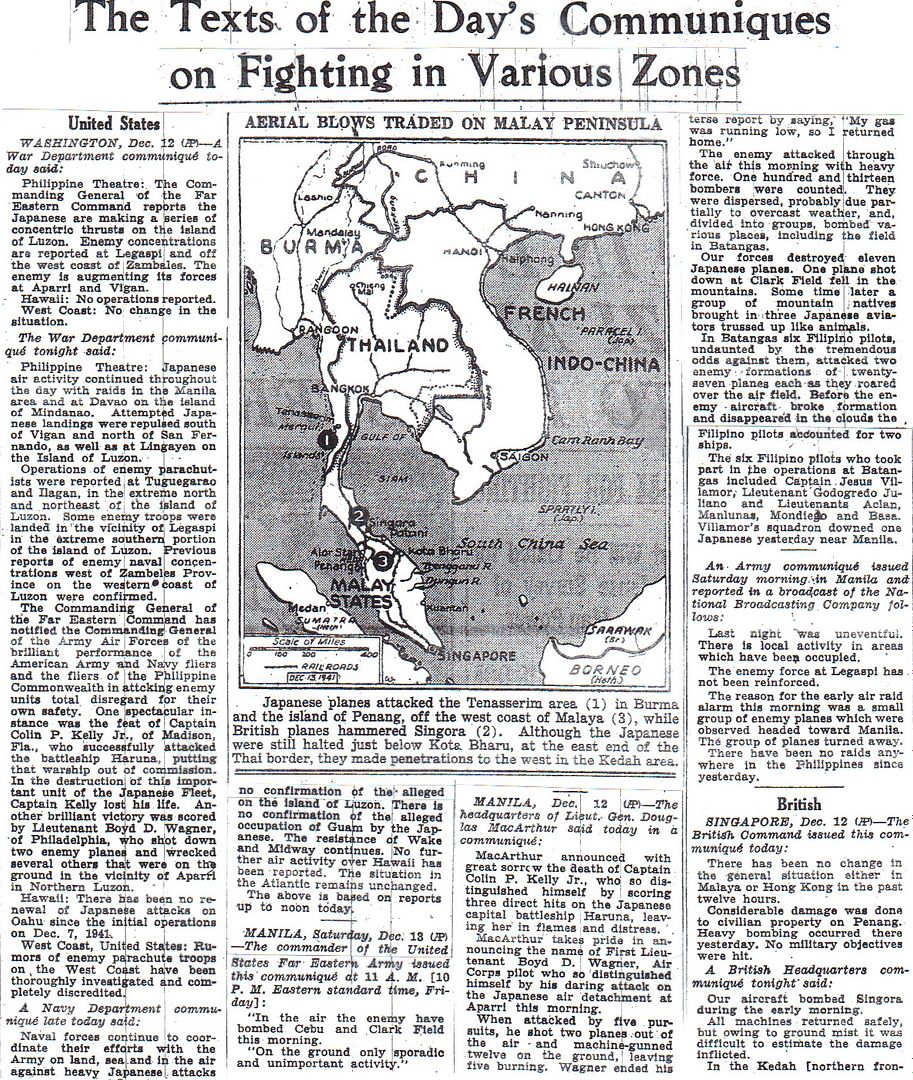

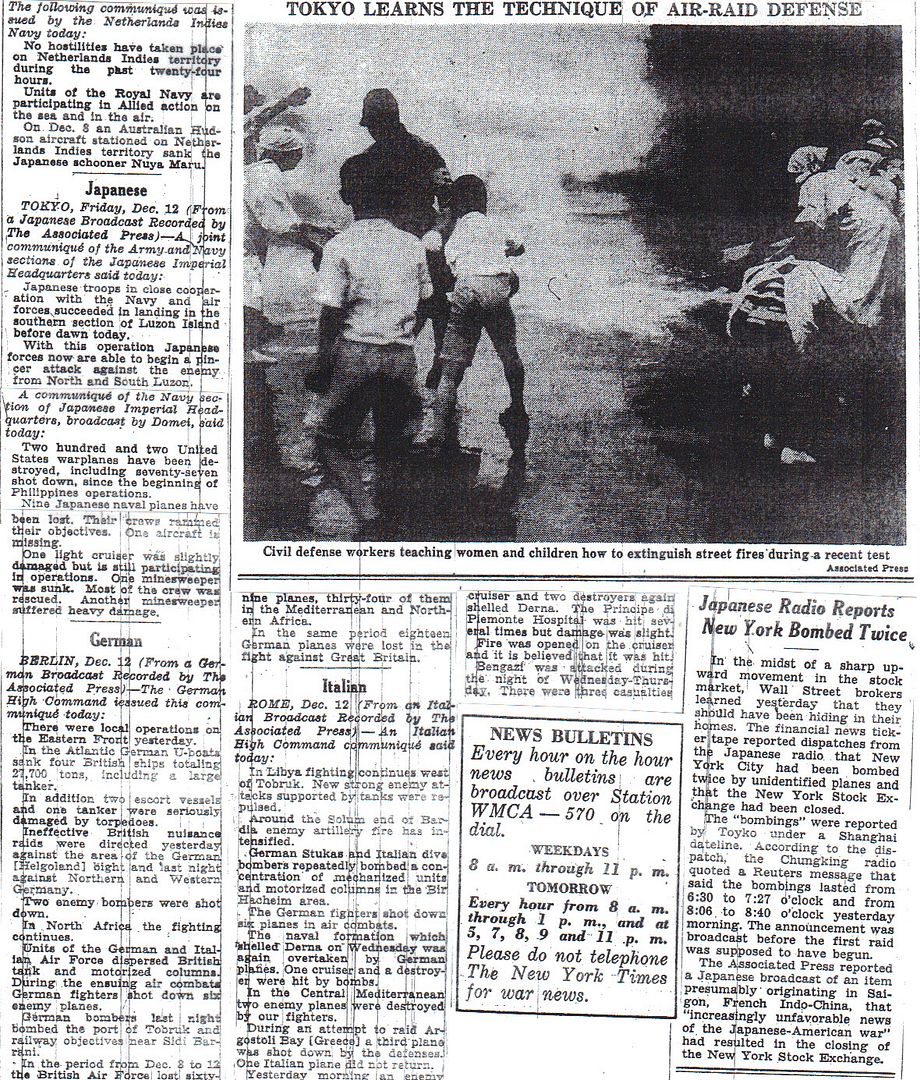
http://homepage.ntlworld.com/andrew.etherington/month/thismonth/14.htm
December 14th, 1941
GERMANY: U-757 launched. (Dave Shirlaw)
SPAIN: U-434 refuelled from the German supply ship Bessel in Vigo. (Dave Shirlaw)
MEDITERRANEAN SEA: The Italian battleship Vittoria Veneto is damaged by a British submarine while escorting an Italian convoy to Benghazi, Libya. This with previous losses prompts the Italians to recall the convoy.
Cruiser Galatea is torpedoed by U-577 (OLtzS. Ottokar Paulshen, CO). She is hit by multiple torpedoes and sinks in three minutes, 30 miles West of Alexandria at 31 12N 29 15E. There are 470 casualties but 144 survivors are rescued by HMS Griffin and Hotspur. (Alex Gordon)(108)
MALAYA: The Japanese force advancing from Patani has reached Kroh.
CANADA: Minesweeper HMCS Port Hope launched Levis, Province of Quebec. (Dave Shirlaw)
U.S.A.: The USAAF 77th Bombardment Squadron (Medium) departs Gowen Field, Boise, Idaho destined for Alaska. (Jack McKillop)
ATLANTIC OCEAN:
U-108 sank SS Cassequel.
U-160 lost 7 men dead and one wounded in a fire at Danzig during the boat’s working up exercises.
Oblt. Hans-Jürgen Radke of U-657 was killed in a fire on the living quarters ship Black Prince. That fire killed 28 men. The boat was still going through trials at the time.
U-A met the Italian submarine Luigi Torelli in the mid-Atlantic and transferred 50 survivors from the German support ship Python and Atlantis. (Dave Shirlaw)
I think I’ll be eating at Luchow’s.
http://www.onwar.com/chrono/1941/dec41/f13dec41.htm
Allies attack Italian supply shipments
Saturday, December 13, 1941 www.onwar.com
In the Mediterranean... Two Italian cruisers carrying fuel are sunk off Cape Bon by three British and one Dutch destroyer. Italian navy begins a major convoy to bring supplies to Benghazi supported by their main fleet. Two transports are sunk by a British submarine.
In Hong Kong... British and Canadian forces withdraw from the mainland to Hong Kong Island.
In Burma... British abandon their airfield at Victoria Point on the Kra Isthmus. Japanese occupy it.
In North Africa... British forces close in Gazala but are held temporarily by German counterattacks. Rommel plans further withdrawal due to reduced supplies.
No extra charge for the preview of tomorrow’s post from etherington.com.
http://homepage.ntlworld.com/andrew.etherington/month/thismonth/13.htm
December 13th, 1941
UNITED KINGDOM: Destroyer HMCS Restigouche enroute to join convoy ON-44 suffered storm damage; requiring extensive repairs at Greenock. (Dave Shirlaw)
Minesweeper HMS Cromarty commissioned. (Dave Shirlaw)
FRANCE: An explosion in Brest killed one crewman on U-201; Maschinenobergefreiter Josef Zander. (Dave Shirlaw)
GERMANY: U-258 and U-441 launched. (Dave Shirlaw)
BULGARIA declares war on the United States. (Dave Shirlaw)
U.S.S.R.: Moscow: The Germans have admitted that they have been defeated before Moscow, but they are blaming it on the weather rather than the Red Army. “The army”, said Berlin tonight, “does not expect to capture Moscow this year. Major campaigning must be suspended until the spring. Then Moscow can be taken ...” “Officers and men trying to take cover freeze to the ground,” said a spokesman. “Fighting under these conditions is practically impossible. We have no reason to expose our troops to the terrible rigours of the Russian winter.”
MEDITERRANEAN SEA: Battle of Cape Bon. In a brilliant night action the Italian 4th Cruiser Division, Contrammiraglio Admiral Antonio Toscano, Commander, is attacked by the British 4th Destroyer Flotilla, Commander G. H. Stokes, Commander. Two Italian Barbiano-class light cruisers, Alberico Da Barbiano and Alberto Di Giussano are sunk. The allied force is composed of destroyers HMS Sikh, Maori, Legion and HNLMS Isaac Sweers. The Italian torpedo boat Cigno, Capitano di Corvetta Riccardi, CO, which had been a last-minute substitute for the cruiser Bande Nere when that cruiser had mechanical problems, escaped. The Italians also begin a major convoy to Benghazi using their main fleet, with battleships, as escort. Two of the transports are sunk today by a British submarine. (Dave Shirlaw)
NORTH AFRICA: British forces close the Gazala position despite heavy losses to German counterattacks.
BURMA: The Japanese occupy the Victoria Point airfield after evacuation by the British. This airfield is in the far south on the Kra Isthmus.
Mingaldon Air Base, Rangoon: The 3rd Squadron American Volunteer Group- Chinese Nationalist Air Force, ground echelon, arrive. Mingaladon barracks had the smell of curry, urine, and mildew. Our 18 P-40s came in on the 13th. AVG40s and RAF Buffalos ( mostly New Zealand pilots) scrambled on an alert but no contacts. (Chuck Baisden)
THAILAND: Bangkok: In a move causing deep concern to neighbouring Burma and Malaya, the Thai government will tomorrow sign a formal treaty legitimizing the Japanese invasion on 8 December. In return for free passage for its troops, Japan has “promised to respect Thailand’s integrity”. Japanese troops now occupy Singora and Patani, near the Malayan border and Siemrap, on the Indochinese frontier.
HONG KONG: The British forces stationed on the mainland withdraw.
Britain’s Crown Colony is in a full state of siege following the evacuation today of the last British, Canadian and Indian troops from the mainland across the harbour to Hong Kong Island after five days of fighting. The decision to evacuate came after the Japanese 38th Division broke through the last mainland line of defence, the reinforced redoubt known as the Gindrinkers’ Line. Hong Kong lost its limited air force in the first few hours of the conflict and has been hit by incessant air bombardment since.
MALAYA: Five days after their first surprise landings Japanese forces now control northern Malaya’s two key airfields, following the capture today of Alor Star on Malaya’s northwest coast. The town was taken by Japanese troops advancing across the Thai isthmus from Singora, in south-east Thailand, the site of major landings five days ago.
Japan’s commander, General Yamashita, now has overwhelming air and sea superiority following the sinking of four of the six ships in the British Far East Fleet, including the battle-cruiser HMS Repulse and the battleship HMS Prince of Wales with the loss of 840 lives three days ago. With four times as many aircraft Yamashita’s 25th Army is well positioned to strike south to take Singapore, Britain’s naval base for the Far East, inside the 100-day target set by Tokyo.
However, British strategists believe that Yamashita cannot stage a full attack on Malaya until he has consolidated his forces in Thailand in order to attack Burma. Yamashita is not expected to push south from the airfield captured at Kota Bharu, on the north-east coast, because of dense jungle.
BORNEO: Indian troops destroy oil installations in Sarawak and Brunei.
COMMONWEALTH OF THE PHILIPPINES: Manila: Japanese forces enjoying total air and sea superiority have now gained footholds at several strategic points on the main Philippines island of Luzon. Landings and parachute drops at three locations have placed them within 250 miles of the capital Manila.
Three detachments of General Homma’s Formosa-based 14th Japanese Army, each with 2,000 men are now at Aparri in the north, Vigan in the north-west and Legaspi in the south-east. Japanese marines and Filipino soldiers fought hand-to-hand at Aparri. US authorities in Manila are claiming the situation is “well in hand.”
Yet most acknowledge that, now that there is no air cover, it is only a matter of time before the Japanese try to invade Manila in force. Only ten US bombers and a few fighters have survived the Japanese raids on airfields here, while the US Navy yard at Cavite has been destroyed. General Homma, however, has lost only seven of his 490 planes.
52 soldiers of the 48th Material Squadron the US Army Air Corps volunteer to go on an operation that has been dubbed a “suicide mission.” These men include Armand Toussaint and Louis G. Kolger.
They are to build a secret airfield in San Jose on Mindoro Island. One in a chain of airfields south to Australia where Allied aircraft can be refuelled and repaired.
“They told us, ‘You’re not coming back,’” Louis G. Kolger, on of the few surviving members of Toussaint’s squadron said during a telephone interview from his home in Cincinnati. Kolger, 86 (in 2004), a staff sergeant at the time, said even after hearing those words, no one balked at going.
“We were all pretty naïve but it was a good bunch of guys and they stepped forward because they had to do it,” he said.
In a telephone interview from his home in Baton Rouge, La., one of those men, Kenneth Calvit, said they boarded a steamer and sailed through Manila Bay disguised as Filipino fishermen to trick Japanese pilots. It worked.
They arrived at San Jose, a small village based around a sugar plantation and set up the airfield where B-17 bombers and P-40s could be serviced.
By February 1942, more than half of the squadron had malaria. A month later, about 500 Japanese landed near San Jose, forcing the Americans into secondary camps they had set up in the mountains.
Calvit was sitting in a library they had built on the island when he saw the Japanese troops.
“I jumped out of the window and ran like hell,” Calvit said. After burning more than 70,000 gallons worth of fuel and burying tools, the Americans fled into the mountains but continued to relay intelligence about the Japanese to Bataan.
Then on April 10, 1942, Bataan surrendered. The squadron was on its own.
At the end of the month, the squadron relocated to avoid capture. Pvt. Paris J. Palmer, Toussaint’s close friend, developed tropical ulcers on his feet and could not continue so Toussaint “refused to leave him and stayed behind,” according to records.
Palmer was eventually captured and beheaded. Toussaint joined a guerrilla movement of Filipinos against the Japanese, according to testimony from Maj. Jose L. Garcia, who told United States officials that Toussaint was his executive officer. Toussaint fought with the guerrillas until August 1943 when he became ill and was captured by the Japanese.
Records of Masutaro Iwasaki’s trial revealed that Toussaint was tortured in an effort to force him to tell where the Americans had buried aircraft tools and equipment. They also describe how a Japanese commanding officer asked Toussaint what he wanted after he had been savagely beaten.
“Pvt. Toussaint replied that they had already kicked his eyes out and that they might just as well kill him,” the records said. He was then bayoneted to death.
A United States military court in Yokohama, Japan, sentenced Masutaro Iwasaki, a 39-year-old major in the Japanese Imperial Army to 15 years in prison for ordering his troops to beat and kill Toussaint.
“Witnesses testified Toussaint was tied to a flagpole and beaten by Japanese soldiers with firewood and kicked by hobnail boots for two hours,” the article said. “They said he was beaten so badly that one eyeball was bulging when he was ordered to dig his own grave. On the brink of the grave, the witnesses said, Toussaint was blindfolded and bayoneted in the stomach and back until he fell into the grave.”
(Alaine Griffin forwarded by Peter Kilduff)(214)
CANADA: Minesweeper HMCS Bellechasse commissioned.
Corvette HMCS Lunenburg arrived Halifax from builder Quebec City, Province of Quebec.
Minesweepers HMCS Melville and Medicine Hat arrived Halifax from builders Quebec City, Province of Quebec and Montreal, Province of Quebec respectively.
Corvette HMCS Charlottetown commissioned.
(Dave Shirlaw)
U.S.A.: The US makes its first request to Japan to exchange diplomats.
Washington: Shocked by the perfidy of the attack on Pearl Harbor, Americans are flocking to volunteer for the United States Navy and the Marine Corps, which do not take conscripts. In the meantime the US Army has grown almost tenfold since the Selective Service Act introduced conscription, known here as the “draft”, in 1940.
In September 1939 the US Army’s strength was only 174,000 men, less than Portugal. The Burke-Wadsworth Act of June 1940 provided for a year of training for 1.4 million men.
Some concern has been expressed about the poor physical condition of conscripts, especially those from the industrial regions and southern states.
Guatemala, Costa Rica, Honduras, Panama, El Salvador and Nicaragua all break off diplomatic relations with Germany. (Mike Yared)
ATLANTIC OCEAN:
U-431 damaged SS Myriel.
U-453 sank SS Badalona.
Commander William A. Sullivan designated the first Supervisor of Salvage with office in New York City. (Dave Shirlaw)
Good choice. The goose dinner only comes once a year.


The Rev. Dr. Colin P Kelly III
"The Rev. Dr. Colin P Kelly III has been the Rector of Trinity On The Hill Episcopal church for approximately 20 years now. He is extremely dynamic, not just within the church, but thoughout the town of Los Alamos. He is known not only for helping with the spiritual growth of established Episcopalians, but is exceptionally gifted with directing those "church seekers" in finding the right environment in which to worship. If you would like to talk with Father Kelly, please call the church office at 662-5107 to schedule a meeting."
Interesting the number of people on the east coast who believed their cities would be subject to air raids.
While Kelly was apparently a brave man, he did not sink the battleship Haruna! I haven’t had a chance to find out whether it was a different Kongo class battleship...
http://en.wikipedia.org/wiki/Japanese_battleship_Haruna
“Haruna fought in almost every major naval action of the Pacific Theater during World War II. She covered landings of Japanese forces in Malaya (in present-day Malaysia) and the Dutch East Indies (now Indonesia) in 1942 before engaging American forces at the Battle of Midway and during the Guadalcanal Campaign. Throughout 1943, Haruna primarily remained at Truk Lagoon (Micronesia), Kure Naval Base (near Hiroshima), Sasebo Naval Base (near Nagasaki), and Lingga (in present-day Malaysia), and deployed on several occasions in response to American carrier airstrikes on Japanese island bases. Haruna participated in the Battle of the Philippine Sea and the Battle of Leyte Gulf in 1944, engaging American vessels in the latter. In 1945, Haruna was transferred to Kure Naval Base, where she was sunk by aircraft of Task Force 38 on 28 July 1945.”
It wasn’t a Kongo class battleship for sure. There were only four of them and from what I know their fates are as follows:
Kongo - Sunk 21 Nov. 1944 in East China Sea. Only IJN Battleship to be sunk by a submarine.
Hiei - Sunk 13 Nov. 1942 in the naval battle around Guadalcanal. It was hit by SBD dive bombers, TBF torpedo planes and even USAAF B-17 bombers.
Kirishima - Sunk 15 Nov. 1942 in the ongoing naval battle around Guadalcanal. One of my favorite naval battles as the Kirishima uses the South Dakota as a punching back while the Washington takes the Kirishima out. The South Dakota even after taking a ton of punishment is still seaworthy.
Haruna - Sunk 28 July 1945. In the waning days of the war, the Haruna is sunk at Kure in shallow water. It was already effectively out of the war by now as BatDiv 1 had been disbanded the previous February and the ship was just on coastal defense duty.
Combinedfleet.com has a more extensive accounting of all these ship’s actions.
Hyperwar purports to have a chronological listing of Japanese naval losses.
No capital ships shown for December, 1941.
To date, 2 destroyers, 2 minesweepers, and a sub.
The minesweepers were the only ships to date lost to army aircraft
http://www.ibiblio.org/hyperwar/Japan/IJN/JANAC-Losses/JANAC-Losses-3.html
Thanks! Fog of war?
Thanks! Fog of war?
Hard to say. Probably hit one of the minesweepers. It could be his buddies expanded on the story, but I’d be more likely to blame MacArthur’s spinmeisters. The country needed heroes - they were passing out undeserved Medals of Honor at Pearl, as well as the merited ones. So take a story with a bit of truth, and polish it for the public.
Disclaimer: Opinions posted on Free Republic are those of the individual posters and do not necessarily represent the opinion of Free Republic or its management. All materials posted herein are protected by copyright law and the exemption for fair use of copyrighted works.